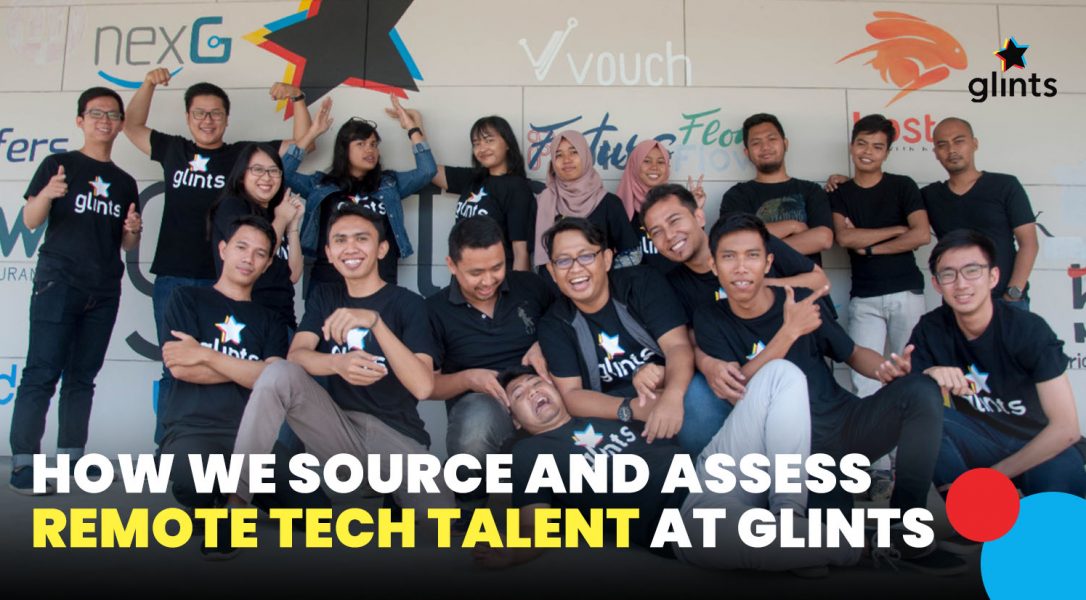How we source and assess remote tech talent at Glints


For startup founders and employers looking for a way to break into the world of remote hiring, look no further. You’d likely have concerns about how to make it work with remote tech talent you might never meet with in person. Don’t worry – we’ve got you covered. Earlier this week, we had a quick chat with our CTO, Ying Cong, about the entire process of sourcing and assessing a remote tech team.

As it turns out, a lot of thought goes into it. We’ll take you through the workflow and thought process of assessing remote tech teams at Glints right here.
Table of Contents
ToggleWhat’s on Glints’ wishlist when it comes to sourcing remote tech talent? The people we have in mind are competent and nothing less than awesome, often buffed up with “language, skill, and experience requirements.” Once our dream candidate is sorted out, we’ll hammer out the overall budget and start putting up job postings on places like AngelList.
Once remote tech talent start applying, technical assessments and interviews will be arranged – usually through Calendly to save the trouble of figuring out common time slots for everyone.

“Assessment is not too different from that of onsite developers,” says Ying Cong. But we do prefer being specific, like having “more focus on online communication skills” and being able to pass our technical tests.
The first round of assessment happens over Skype in order to get a general sense of the candidate. Afterwards, they’re given a take-home assignment to work on, focusing on their specific skill areas. Often, it’s the candidate who proposes a timeline for this assignment, based on their personal schedule.
The final interview will take place afterward, where candidates are taken through technical problems, code walkthroughs for their assignment, and general culture fit questions.
Our remote tech talent are assessed according to their quality, according to Ying Cong. They’re also “qualified by higher standards for communication skills and etiquette.” It’s these higher standards that set them apart from other remote talent and help them to make the cut at Glints.
“They have to be ready to hit the ground running,” Ying Cong said. He described an awesome tech team as “one that’s diverse in skill sets and opinions, yet consistent in their discipline of sticking to core processes and goals.”

A typical remote tech team working for Glints will have about 3-5 members. The relatively small number was decided upon for several reasons.
“We are very sparing and conscious about the remote to onsite developer ratio,” said Ying Cong. Citing “significant communications overhead,” “cultural costs,” and “infrequent face-to-face team collaboration,” Glints is mindful about the size of its remote tech teams.
Putting a remote tech team to the test happens across Glints’ quarterly work cycles, broken down into fortnightly sprints. “Remote team members work with onsite ones without distinction,” Ying Cong said, “and together, they take on projects.”
And as for assessing a remote tech team while it works? “It’s based on peer review and team results,” he revealed. Underperformance, he believes, is obvious when different teams review each other’s work.
At Glints, we keep our remote tech teams in the loop as much as possible. “We default to Slack for major announcements, thus placing remote employees on equal footing when it comes to [accessing] intra-company information,” Ying Cong said. “We divert most communications to public channels for their benefit.” No more being the last to find out about big changes!

Managing remote tech talent isn’t always a bed of roses. Culture fit is a concern to Ying Cong, especially when hiring remote talent.
“There’s a deep undercurrent of subtle information your brain picks up about a person in face-to-face interactions,” he pointed out. “Video conferencing throttles that bandwidth. I’ve had outstanding remote candidates who checked all the boxes prior to their employment only to flounder spectacularly during crunch time. A face-to-face meeting would have triggered some Spider-Sense early on.”
He acknowledged that “in-person assessment is rare.” Travel costs are “rarely justified by an uncertain hire.” However, if a remote tech team is “geographically nearer,” like in Batam, Glints will often arrange for regular fly-ins to work through certain projects with onsite counterparts.
Sourcing and assessing remote tech talent might seem like a lot of work. But the payoff justifies the means. Think about the money you’ll save on that budget if you hire remote talent! You might have to spend a bit more time determining if a remote tech team will work for you and your company, but finding the right candidates could mean major growth.
Looking for remote tech talent of your own? Batam’s filled with them – especially Nongsa Digital Park. Click here to find out more about how to make the best of that talent pool!